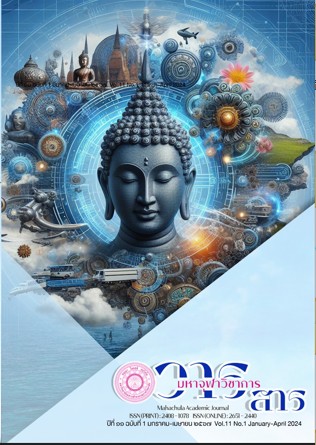Satipatatana: Four Foundation of Mindfulness Program in Psychotherapy for Depressed Patients in Hua Hin Hospital
Main Article Content
Abstract
The study consisted of the following three objectives: 1) to investigate meditation practice based on the four foundations of mindfulness in Buddhist text; 2) to explore the psychotherapy approach by using Satipaṭṭhāna with depressed patients and propose a model for Hua Hin hospital; and 3) to examine the content validity index (CVI) of a psychotherapy model based on Satipaṭṭhāna with depressed patients in Hun Hin hospital. The study employed a qualitative research method by collecting data via documents and in-depth interviews. The content validity index (CVI) was assessed by seven experts and seven depressed patients.
From the study, the following results are found: The concept of Satipaṭṭhāna and meditation practice based on Satipaṭṭhāna can be found in primary texts in great detail. Mahāsatipaṭṭhāna (the Four Foundations of Mindfulness) is concerned with the cultivation of mindfulness as the main path leading meditation practice to the attainment of the path, fruition, and Nibbāna. Mahāsatipaṭṭhāna can be divided into four foundations as follows: (1) Kāyānupassanā (contemplation of the body); (2) Vedanānupassanā (contemplation of feelings); (3) Cittānupassanā (contemplation of mind); and (4) Dhammānupassanā (contemplation of mind-objects). Satipaṭṭhāna relies on the continuous co-working between mindfulness and contemplation based on ātāpī, sampajāno, satimā (ardent, fully aware and mindful). Psychotherapy based on Satipaṭṭhāna with depressed patients should follow a continual practice of mindfulness in order to be mindful of what is happening in the moment. This will increase the practitioner's mindfulness and awareness, allowing him to recognize and manage the cycle of thoughts, emotions, and feelings. The following is a psychotherapy model based on Satipaṭṭhāna that specifies 7 times, 90 minutes of continuous practice, covering all 4 bases: the scale content validity index (S-CVI) of all seven experts is between 0.86 – 1.00. The mean of the content validity index is 0.94, while the content validity index of each item (I-CVI) is 0.94 and the average of the sum proportion of all experts is 0.94. After being assessed by all seven depressed patients, the content, psychotherapy model, and its application are at 1.00, indicating a very good level. The good rating is consistent with in-depth interviews with two groups: the expert group unanimously agrees that the content is academically correct and appropriate for both therapists and practitioners, and that it can be utilized to treat or lessen depression while also benefiting depressed patients, as does the depressed patient group, which unanimously agrees that a psychotherapy model allows one to understand methods and implement them appropriately while also benefitting negative emotional management in depressed patients.
Article Details

This work is licensed under a Creative Commons Attribution-NonCommercial-NoDerivatives 4.0 International License.
References
คณะทำงานการจัดการความรู้ พ.ศ.๒๕๕๔ กรมสุขภาพจิต. คู่มือรูปแบบการดูแลสังคมจิตใจสำหรับเครือข่ายบริการสุขภาพจิตและจิตเวช. กรุงเทพมหานคร: โรงพิมพ์องค์การรับส่งสินค้าและพัสดุภัณฑ์, ๒๕๕๔.
เต็มหทัย นาคเทวัญ. “Interesting topic : Mindfulness - based Psychotherapy”. เอกสารบรรยาย. สงขลา: คณะแพทย์ศาสตร์ มหาวิทยาลัยสงขลานครินทร์, ๒๕๖๒.
บุณชญา วิวิธขจร. “การปฏิบัติวิปัสสนากรรมฐานตามแนวสติปัฏฐาน ๔”. รายงานวิจัย. มหาวิทยาลัยมหาจุฬาลงกรณราชวิทยาลัย วิทยาเขตบาฬีศึกษาพุทธโฆส, ๒๕๕๙.
พระพรหมคุณาภรณ์ (ป. อ. ปยุตโต). พุทธธรรม ฉบับปรับปรุงและขยายความ. พิมพ์ครั้งที่ ๑๕. กรุงเทพมหานคร: สหธรรมิก, ๒๕๕๒.
มหาจุฬาลงกรณราชวิทยาลัย. พระไตรปิฎกภาษาไทย ฉบับมหาจุฬาลงกรณราชวิทยาลัย. กรุงเทพมหานคร: โรงพิมพ์มหาจุฬาลงกรณราชวิทยาลัย, ๒๕๓๙.
สุจิตรา เทียนสวัสดิ์. “ดัชนีความตรงเชิงเนื้อหา: ข้อวิพากย์และข้อเสนอแนะวิธีการคำนวณ”. วารสารพยาบาลสาร. ปีที่ ๓๔ ฉบับที่ ๔ (ตุลาคม–ธันวาคม ๒๕๕๐): ๑-๙.
ณัทธร พิทยรัตน์เสถียร. “อีกทางเลือกปัญหาสุขภาพจิต: CBT การบำบัดด้วยความคิดและพฤติกรรม กับ ผศ.นพ.ณัทธร พิทยรัตน์เสถียร”. [ออนไลน์]. แหล่งที่มา: https: // www .the 101. World / cognitive – behavior -therapy/ [๒ กุมภาพันธ์ ๒๕๖๖].
ราชบัณฑิตยสถาน. พจนานุกรมฉบับราชบัณฑิตสถาน พ.ศ.๒๕๕๔ ฉบับออนไลน์. [ออนไลน์]. แหล่งที่มา: https: // dictionary. orst.go.th/ [๑๖ มีนาคม ๒๕๖๖].
American Psychiatric Association. Practice Guideline for the Treatment of Patients with Major Depressive Disorder -Third Edition. USA: APA Publishing, 2010.
Burden of Disease Thailand. “Report of the burden of disease and injuries of Thai population 2.11”. Burden of Disease Research Program Thailand (BOD Thailand) International Health Policy Program. [Online]. Available: http: // bodthai.net [1 September 2021].
World Health Organization. “Key facts: Depression”. World Health organization. [Online]. Available: https:// www. who.int/ news-room /fact-sheets/ detail/ depression [10 September 2021].


